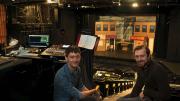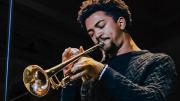The Act One finale of In the Heights is the stuff of theater technicians’ dreams andnightmares. After a blackout hits their Washington Heights neighborhood, the cast watches a fireworks show which—if lighting designer Finn Bamber ’23 and sound designer Clay Oxford ’23 get it right—will include lights flashing around the stage in time to 70 fireworks sound effects. To make it feel real for the audience, they’ve chosen to sync their cues to one-hundredth of a second.
“We’ll see, though,” Oxford laughs uneasily on the Loeb Drama Center stage, crossing his arms over his Currier House sweatshirt. “A lot of the things that Finn and I are trying to do are kind of pushing the boundaries of what students can do and have done in the past, given the time and resources we have.”
“It’s a little scary,” says Bamber, a member of Eliot House concentrating in theater, dance, and media. He laughs. “Well, actually, it’s very scary.”
Technical rehearsals for a Harvard-Radcliffe Dramatic Club mainstage production are a little like being dropped into an episode of The West Wing: people talk at caffeine-fueled speeds, there’s too much to do in too little time, and the stakes are high. For the two weeks before the show opens, the cast and technicians are in the theater daily from 6 p.m. to 11 p.m. or later, conceiving and perfecting the show design and addressing any technical hiccups. Bamber says, “You sort of have to have your brain running on multiple frequencies at once.”
Many students active in Harvard theater name Bamber and Oxford as the campus lighting and sound designers. Bamber, who hopes to pursue lighting design professionally, has been lighting shows since high school. His director there held a lighting training and Bamber was the only one who showed up. Now, he balances schoolwork with lighting some six student productions and a few professional ones each year.
He sees his job as a mishmash of film-industry roles: a cinematographer (“You’re shifting focus in a scene, setting the frame, and allowing people to know what to pay attention to”); gaffer (the chief electrician); and maybe a less obvious comparison, film editor. “Lights give a sense of time, and how time moves through the space,” he says. A scene can end with a sudden blackout, or fade to black slowly as the characters revel in whatever just transpired on stage. “That’s a choice you get to make,” he continues. “You’re deciding the pacing in that way.”
Bamber usually meets with the show’s director to collaboratively build an overall aesthetic vision for the show. He presents her with a slide deck of lighting inspirations, which for this show came mostly from visual art: photographer Carrie Mae Weems’s “Kitchen Table Series” shaped the way he lit interior scenes, while the architectural light in the work of Martin Lewis, Edward Hopper’s mentor, inspired the show’s blackout sequence.
A designer must be technical, creative, experimental—a “poet-scientist.”
He designed 497 individual lighting cues for this show, 114 of which occur in the fireworks sequence alone. “For each cue, you’re working with more than 150 lights,” Bamber notes. “So, for each of those 497 big choices, you’re making about 150 smaller ones.” He’s also installed several professional-grade intelligent lights for even more creative options. Most lights glow one color and stay in one position throughout a show, but intelligent lights can be programmed to change color and pivot anywhere around the stage. He designs every cue in a lighting software and sketches an overhead view of the stage to determine the optimal position for each light, which he then hangs from the theater’s rafters. He says a lighting designer must be technical, creative, experimental, and as one of his teaching fellows put it, a “poet-scientist.”
Oxford’s musical ear got him into sound design. He’s a drummer and conductor, and did live sound for bands in high school. A government concentrator, he hopes to work in international affairs, but took up theater sound design at Harvard for fun. Seasoned upperclassmen and staff at the American Repertory Theater showed him the ropes, and books and YouTube tutorials answered his remaining technical questions.
“Sound is all about inputs and outputs. These are the inputs,” he says, gesturing to the 18 microphones set up in the orchestra pit, “and so are the actors’ mics.” The outputs are what the audience hears, but Oxford also crafts outputs for the musicians and actors. Each musician gets his own “foldback,” a speaker playing a mix of different instruments so they all stay in sync with one another. In total, he’s in charge of those monitors, the 18 microphones on the band, the 20 body mics the actors are wearing—and mixing all of them so the audience hears the best combination of those sounds.
“There’s a lot of cable involved in all this, and none of it is pre-installed,” he says. “Every single power cable, everything had to be loaded in and wired and made to work.” He says his work is closely tied with executing the director’s and composer’s vision: “The music is already written. It’s my job to make it sound as good as possible.”
He has two sound assistants for In the Heights, but for most of the other shows he designs, Oxford live mixes the performances himself at the control console in the back of the theater, adjusting actors’ and instruments’ microphone levels to create a balanced sound. During a performance, he slides the faders controlling their mics up and down and toggles rapidly among controls, as if playing a horribly complicated and high-stakes arcade game. “The job of a sound designer is technical in that you have to understand how the system works and what to do when something breaks,” he says. “But it’s also very artistic in that you have to know what vocal lines in a song are important to bring out, and which moments are important to emphasize.”
Beyond Bamber and Oxford, a fleet of student technicians collaborate to bring the show to life. Alongside 20 cast members, In the Heights has about 80 student technicians: from costume and set designers to the stage crew who move set pieces between scenes and the stage managers who ensure the lights, sound, and actors all make their cues. Oxford says, “There’s so many people working to make this as immersive of a world as possible for the audience.”
Five days later, it’s opening weekend and the question remains whether that 100-person team can pull off the fireworks sequence. The moment comes and the characters gather at the edge of the stage. Oxford’s first firework sound goes off to the right of the audience, exploding just as Bamber’s lights burst pink and green. A Roman candle sound soars while a corresponding pink light rises over the actors’ faces. Everything is perfectly, beautifully timed. “It’s really, really hard,” Oxford says, “but it’s also really, really cool when it all comes together. There’s nothing else like it.”








